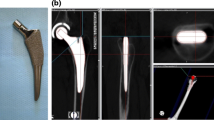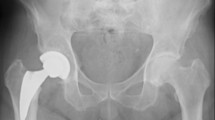Abstract
Purpose
This study was performed to compare short and standard-length tapered-wedge-type femoral stems in single-stage bilateral total hip arthroplasty (THA) through a direct anterior approach (DAA).
Materials and methods
The patients were divided into two groups according to their femoral stem types as short tapered-wedge stem and standard-length tapered-wedge stem groups. Outcome parameters were the surgical time, estimated blood loss (EBL), length of stay (LOS), thigh pain, Harris Hip Score (HHS), and visual analog scale (VAS) score clinically, and canal fill ratio (CFR), coronal plan alignment of the stems, subsidence, and postoperative leg length difference (LLD), radiologically.
Results
The short-stem group and standard-length-stem group consisted of 20 patients (40 hips, mean age 52.0 ± 14.1) and 22 patients (44 hips, mean age 49.4 ± 11.9), respectively. There were no significant differences between the groups in terms of mean surgical times (p = 0.6), EBL (p = 0.2), LOS (p = 0.2), the rate of thigh pain (p = 0.4), improvements in HHS (p = 0.4) and VAS scores (p = 0.6), LLD (p = 0.3), amount of subsidence (p = 0.9), and varus or valgus misalignment (p = 0.7). The CFR at the level of the lesser trochanter was significantly higher in the short-stem group (0.79 ± 0.1) than the standard-length-stem group (0.73 ± 0.1) (p < 0.01).
Conclusion
In single-stage bilateral THA through DAA, short, tapered-wedge femoral stems provide similar radiographic and functional results to standard stems at short-term follow-up.



Similar content being viewed by others

Data availability
The datasets generated during and analyzed during the current study are available from the corresponding author on reasonable request.
References
Goebel D, Schultz W (2009) The Mayo cementless femoral component in active patients with osteoarthritis. Hip Int 19:206–210. https://doi.org/10.1177/112070000901900303
Rometsch E, Bos PK, Koes BW (2012) Survival of short hip stems with a “modern”, trochanter-sparing design - a systematic literature review. Hip Int 22:344–354. https://doi.org/10.5301/HIP.2012.9472
Patel RM, Stulberg SD (2014) The rationale for short uncemented stems in total hip arthroplasty. Orthop Clin North Am 45:19–31. https://doi.org/10.1016/j.ocl.2013.08.007
Taunton MJ, Mason JB, Odum SM, Springer BD (2014) Direct anterior total hip arthroplasty yields more rapid voluntary cessation of all walking aids: a prospective, randomized clinical trial. J Arthroplasty 29:169–172. https://doi.org/10.1016/j.arth.2014.03.051
Matta JM, Shahrdar C, Ferguson T (2005) Single-incision anterior approach for total hip arthroplasty on an orthopaedic table. Clin Orthop Relat Res 441:115–124. https://doi.org/10.1097/01.blo.0000194309.70518.cb
Christensen CP, Karthikeyan T, Jacobs CA (2014) Greater prevalence of wound complications requiring reoperation with direct anterior approach total hip arthroplasty. J Arthroplasty 29(9):1839–1841
De Geest TFP, Lenaerts G, De Loore G (2015) Adverse effects associated with the direct anterior approach for total hip arthroplasty: a Bayesian meta-analysis. Arch Orthop Trauma Surg 135(8):1183–1192
Yildiz F, Aliyev O, Erden T, Gungoren N, Ucan V, Tuncay I (2020) Does performing total joint arthroplasty in the afternoon or evening increase the risk of prosthetic joint infection? Arch Orthop Trauma Surg. https://doi.org/10.1007/s00402-020-03673-3
Chughtai M, Samuel LT, Acuna AJ, Kamath AF (2019) Algorithmic soft tissue femoral release in anterior approach total hip arthroplasty. Arthroplast Today 5:471–476. https://doi.org/10.1016/j.artd.2019.10.004
Hartford JMKS (2016) Risk factors for perioperative femoral fractures: cementless femoral implants and the direct anterior approach using a fracture table. J Arthroplasty 31(9):2013–2018
Berend KRMA, Morris MJ, Lombardi AV Jr (2016) Risk of periprosthetic fractures with direct anterior primary total hip arthroplasty. J Arthroplasty 31(10):2295–2298. https://doi.org/10.1016/j.arth.2016.03.007
Molli RG, Lombardi AV Jr, Berend KR, Adams JB, Sneller MA (2012) A short tapered stem reduces intraoperative complications in primary total hip arthroplasty. Clin Orthop Relat Res 470:450–461. https://doi.org/10.1007/s11999-011-2068-7
Owens WD, Felts JA, Spitznagel EL Jr (1978) ASA physical status classifications: a study of consistency of ratings. Anesthesiology 49:239–243. https://doi.org/10.1097/00000542-197810000-00003
Charlson MEPP, Ales KL, MacKenzie CR (1987) A new method of classifying prognostic comorbidity in longitudinal studies: development and validation. J Chronic Dis 40(5):373–383. https://doi.org/10.1016/0021-9681(87)90171-8
Gross JB (1983) Estimating allowable blood loss: corrected for dilution. Anesthesiology 58:277–280. https://doi.org/10.1097/00000542-198303000-00016
Barrack RL, Paprosky W, Butler RA, Palafox A, Szuszczewicz E, Myers L (2000) Patients’ perception of pain after total hip arthroplasty. J Arthroplasty 15:590–596. https://doi.org/10.1054/arth.2000.6634
Ishii S, Homma Y, Baba T, Ozaki Y, Matsumoto M, Kaneko K (2016) Does the canal fill ratio and femoral morphology of asian females influence early radiographic outcomes of total hip arthroplasty with an uncemented proximally coated, tapered-wedge stem? J Arthroplasty 31:1524–1528. https://doi.org/10.1016/j.arth.2016.01.016
Gromov K, Bersang A, Nielsen CS, Kallemose T, Husted H, Troelsen A (2017) Risk factors for post-operative periprosthetic fractures following primary total hip arthroplasty with a proximally coated double-tapered cementless femoral component. Bone Joint J 99-B:451–457. https://doi.org/10.1302/0301-620X.99B4.BJJ-2016-0266.R2
Ranawat CS, Rodriguez JA (1997) Functional leg-length inequality following total hip arthroplasty. J Arthroplasty 12(4):359–364. https://doi.org/10.1016/s0883-5403(97)90190-x
Engh CA Jr, McAuley JP, Sychterz CJ, Sacco ME, Engh CA Sr (2000) The accuracy and reproducibility of radiographic assessment of stress-shielding. A postmortem analysis. J Bone Joint Surg Am 82:1414–1420. https://doi.org/10.2106/00004623-200010000-00007
Callaghan JJSE, Pellicci PM, Wilson PD Jr, Ranawat CS (1985) Results of revision for mechanical failure after cemented total hip replacement, 1979 to 1982. A two to five-year follow-up. J Bone Joint Surg Am 67(7):1074–1085
Lindahl H (2007) Epidemiology of periprosthetic femur fracture around a total hip arthroplasty. Injury 38:651–654. https://doi.org/10.1016/j.injury.2007.02.048
Giardina F, Castagnini F, Stea S, Bordini B, Montalti M, Toni A (2018) Short stems versus conventional stems in cementless total hip arthroplasty: a long-term registry study. J Arthroplasty 33:1794–1799. https://doi.org/10.1016/j.arth.2018.01.005
Yu H, Liu H, Jia M, Hu Y, Zhang Y (2016) A comparison of a short versus a conventional femoral cementless stem in total hip arthroplasty in patients 70 years and older. J Orthop Surg Res 11:33. https://doi.org/10.1186/s13018-016-0367-0
Hayashi S, Hashimoto S, Matsumoto T, Takayama K, Niikura T, Kuroda R (2020) Risk factors of thigh pain following total hip arthroplasty with short, tapered-wedge stem. Int Orthop. https://doi.org/10.1007/s00264-020-04762-z
Amendola RL, Goetz DD, Liu SS, Callaghan JJ (2017) Two- to 4-year followup of a short stem tha construct: excellent fixation, thigh pain a concern. Clin Orthop Relat Res 475:375–383. https://doi.org/10.1007/s11999-016-4974-1
Gielis WP, van Oldenrijk J, Ten Cate N, Scholtes VAB, Geerdink CH, Poolman RW (2019) Increased persistent mid-thigh pain after short-stem compared with wedge-shaped straight-stem uncemented total hip arthroplasty at medium-term follow-up: a randomized double-blinded cross-sectional study. J Arthroplasty 34:912–919. https://doi.org/10.1016/j.arth.2019.01.014
Khalily C, Lester DK (2002) Results of a tapered cementless femoral stem implanted in varus. J Arthroplasty 17:463–466. https://doi.org/10.1054/arth.2002.32171
Huiskes R, van Rietbergen B (1995) Preclinical testing of total hip stems. The effects of coating placement. Clin Orthop Relat Res 319:64–76
Jacquel A, Le Viguelloux A, Valluy J, Saffarini M, Bonin N (2019) A shortened uncemented stem offers comparable positioning and increased metaphyseal fill compared to a standard uncemented stem. J Exp Orthop 6:28. https://doi.org/10.1186/s40634-019-0197-1
Rivera F, Leonardi F, Evangelista A, Pierannunzii L (2016) Risk of stem undersizing with direct anterior approach for total hip arthroplasty. Hip Int 26:249–253. https://doi.org/10.5301/hipint.5000337
Author information
Authors and Affiliations
Contributions
All authors were fully involved in the study and preparation of the manuscript.
Corresponding author
Ethics declarations
Ethics approval
This retrospective study was approved by our institutional review board (45446446–010.99–5866). The patient data used in the study were obtained from Bezmialem Vakif University Hospital.
Consent to participate
Not applicable.
Consent for publication
Not applicable.
Competing interests
The authors declare no competing interests.
Additional information
Publisher's Note
Springer Nature remains neutral with regard to jurisdictional claims in published maps and institutional affiliations.
Level of Evidence: Level III, Therapeutic
Rights and permissions
About this article
Cite this article
Uçan, V., Ezici, V., Aliyev, O. et al. Comparison of tapered-wedge short and standard-length femoral stems in single-stage bilateral direct anterior total hip arthroplasty. International Orthopaedics (SICOT) 45, 3119–3127 (2021). https://doi.org/10.1007/s00264-021-05152-9
Received:
Accepted:
Published:
Issue Date:
DOI: https://doi.org/10.1007/s00264-021-05152-9



